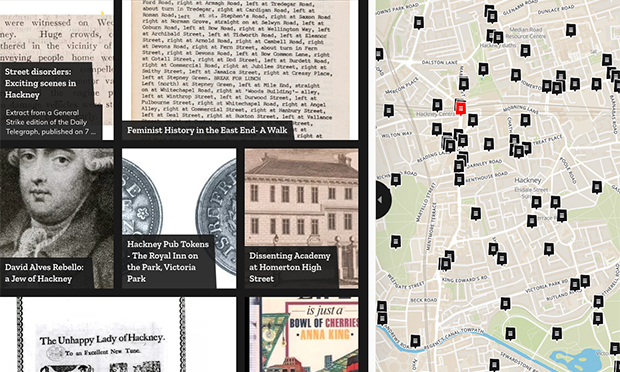Local archivists digitise centuries of Hackney history for online map

Hundreds of years of Hackney’s history will soon be available through an online map thanks to a partnership between local archivists and the University of London.
Friends of Hackney Archives (FoHA), a membership group which supports the work of the borough’s history collection, has been toiling away for months to digitise more than 300 records.
They will be available on the Layers of London map created by the Institute of Historical Research at the University of London.
The project has digitised all back issues of FoHA’s publications, including regular newsletter The Hackney Terrier and its journal Hackney History, and drawn on these to create pop-up historical records which are linked to locations on its map of the capital.
This collection will be launched at FoHA’s annual general meeting on 28 November.
The pop-ups expand to give a taste of the original article when a user hovers over a particular location in Hackney, and can then be clicked on to bring up the full record along with references and citations.
The earliest record relates to Holywell Priory in the 1100s, and the most recent to fighting fascism on Ridley Road in 1962.
Others tell the story of iconic Hackney landmarks such as Abney Park Cemetery, whose record features this extract: “The first interment at Abney Park Cemetery was in 1840. Many more – particularly from Non-Conformist families – followed.
“When the Abney Park Cemetery Company was floated on the Stock Market in 1882, directors were already worried that soon the cemetery would be full.
“By August 1899 there were 100,000 bodies buried and in 1913, 121,676. There were accusations of re-using old graves and there was filling-in alongside pre-existing graves.”
Readers can search for the second issue of Hackney History (1996) to find out more.
Those interested in the site of Cardinal Pole School can read about the Berger paint factory that once stood there: “In 1780, following damage by fire to his Shadwell premises, Berger acquired a green field site in Homerton with the Hackney Brook running through it.
“The move enabled the range of colours to be expanded. Berger’s three sons joined him in the business. The family bought the Hackney House estate to the north of the factory.
“The firm prospered in the first half of the nineteenth century, with improved production methods, rebuilt premises and new colours on offer. By 1860 Lewis Berger and Sons employed 60-70 people.”
This record is taken from a 1988 edition of The Hackney Terrier.
Layers of London also features specialist maps, one of which pinpoints a concentration of furniture-makers in Hoxton.
A record pulled from Jack Whitehead’s Frets, Fakes and Fibreboard in issue nine of Hackney History details a typical production process: “A cabinet maker would receive an order for a dozen tables with pie crust edges and a central column with tripod feet. Much of the work was then sub-contracted out.
“Veneer was selected, cut and glued to a thin wooden board to make the table top. The edging was marked out on mahogany board using a zinc template. Short lengths of edging were glued to the table tops which were then spindled to a smooth curve. The columns were prepared by a turner and the tripod stands shaped by a carver.
“Materials were used as efficiently as possible, avoiding any waste. Nobody was likely to own more than one machine and everyone lived on their earnings from week to week.”
FoHA’s Wendy Forrest said: “We hope that the launch of these records is just the start. We want to involve anyone who is interested in mapping Hackney’s history and adding new records to Layers of London.
“Our first batch of records aims to bring history that has already been researched and documented to a new audience.”
She added: “In future, we would also like to support the recording of histories that may not yet have been captured in this way. Hackney has so many stories to tell about the ways it became the place it is today.
“Friends of Hackney Archives, in partnership with Archives staff, will be running workshops on record-making for interested individuals and community groups.”
For more information about FoHA, including how to become a member, head to hackneyhistory.org
The interactive map can be found at layersoflondon.org
